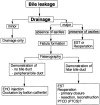Bile leakage after hepatic resection
- PMID: 11141224
- PMCID: PMC1421165
- DOI: 10.1097/00000658-200101000-00008
Bile leakage after hepatic resection
Abstract
Objective: To identify the perioperative risk factors for postoperative bile leakage after hepatic resection, to evaluate the intraoperative bile leakage test as a preventive measure, and to propose a treatment strategy for postoperative bile leakage according to the outcome of these patients.
Summary background data: Bile leakage remains a common cause of major complications after hepatic resection.
Methods: Between January 1985 and June 1999, 781 hepatic resections without bilioenteric anastomosis were performed at the authors' institution. Perioperative risk factors related to postoperative bile leakage were identified using univariate and multivariate analysis. The characteristics of patients with intractable bile leakage and the effect of intraoperative bile leakage test were also examined. Management was evaluated in relation to the outcomes and the clinical characteristics of the patients with bile leakage.
Results: Bile leakage developed in 31 (4.0%) of 781 hepatic resections. This complication carried high risks for surgical death (two patients [6.5%] died). The stepwise logistic regression analysis identified high-risk surgical procedure, in which the cut surface exposed the major Glisson's sheath and included the hepatic hilum (i.e., anterior segmentectomy, central bisegmentectomy, or total caudate lobectomy), as the independent predictor of the development of postoperative bile leakage. None of the 102 cases in which an intraoperative bile leakage test was performed were subsequently complicated by postoperative bile leakage, and the preventive effect of the test was statistically significant. Patients with fisterographically demonstrable leakage from the hepatic hilum and with postoperative uncontrollable ascites had poor outcomes.
Conclusion: Patients with bile leakage from the hepatic hilum and postoperative uncontrollable ascites tend to have a poor prognosis. Therefore, especially when a high-risk surgical procedure is performed in patients with liver cirrhosis, more careful surgical procedures and use of an intraoperative bile leakage test are recommended.
Figures
References
-
- Miyagawa S, Makuuchi M, Kawasaki S, Kakazu T. Criteria for safe hepatic resection. Am J Surg 1995; 169: 589–594. - PubMed
-
- Doci R, Gennari L, Bignami P,et al. Morbidity and mortality after hepatic resection of metastasis from colorectal cancer. Br J Surg 1995; 82: 377–381. - PubMed
-
- Fan ST, Lai ECS, Lo CM, et al. Hepatectomy with an ultrasonic dissector for hepatocellular carcinoma. Br J Surg 1996; 83: 117–120. - PubMed
MeSH terms
LinkOut - more resources
Full Text Sources
Medical



